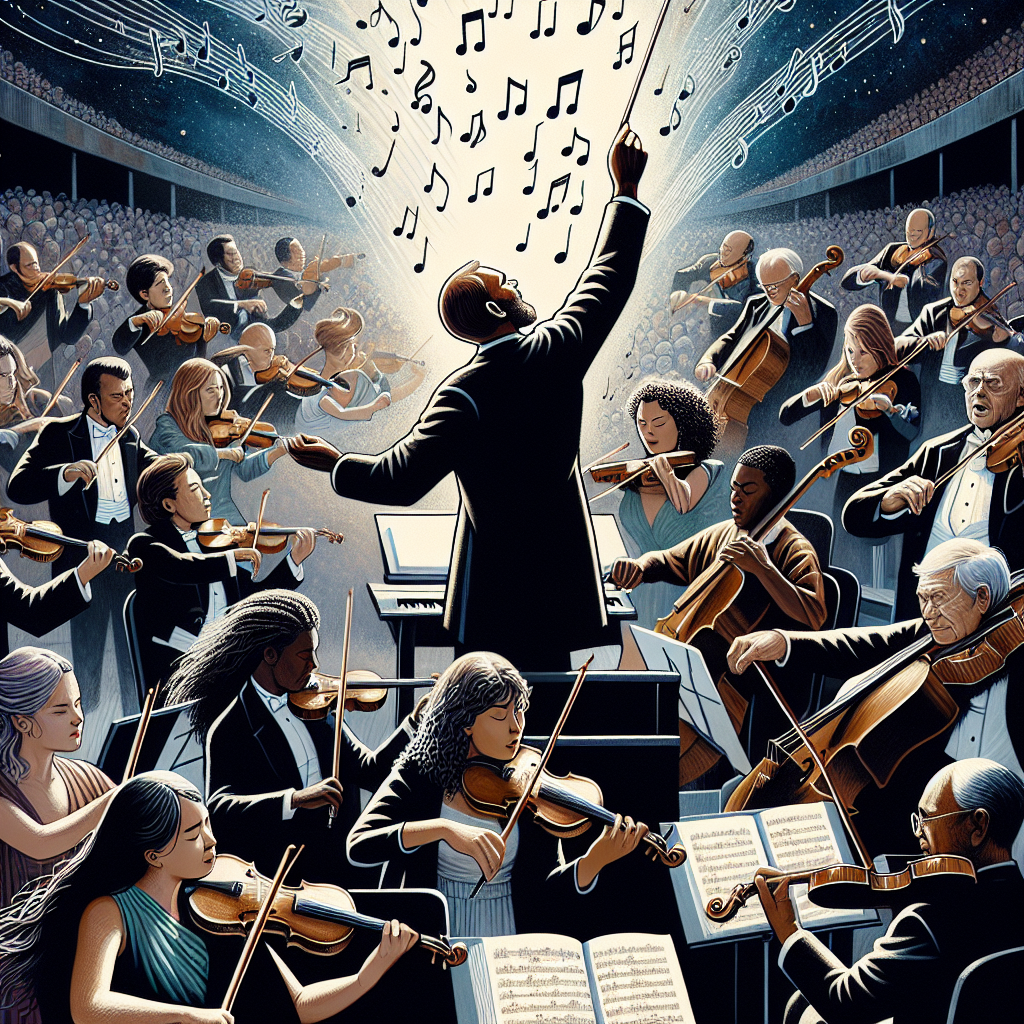
The Ninth Symphony – A Masterpiece of Hope and Unity
Ludwig van Beethoven, one of the most influential composers in history, is a towering figure in Western classical music. Born in Bonn, Germany, on December 17, 1770, Beethoven transformed the arts with his revolutionary compositions and indomitable spirit. His Ninth Symphony, in particular, stands as a testament to his genius, resilience, and the human capacity for hope and unity. Widely recognized for its grandeur and emotional depth, the Ninth Symphony exemplifies Beethoven’s ability to convey profound messages through music. As we delve into the life and work of this maestro, it is crucial to understand the personal and historical contexts that shaped this magnificent piece.
Beethoven was born into a musical family. His grandfather was a Kapellmeister, and his father was a singer in the Elector of Cologne’s court. This musical environment fostered his early talent, and he began composing at a young age. However, his childhood was far from idyllic; his father was an alcoholic who often abused him, hoping to mold him into a child prodigy like Mozart. Despite these challenges, Beethoven’s prodigious talent shone through, and he soon found himself studying under some of the greatest musicians of his time, including Joseph Haydn.
A pivotal moment in Beethoven’s life was his move to Vienna in 1792, a city that was then the epicenter of the classical music world. There, he gained recognition as a virtuoso pianist and innovative composer. However, his musical career was threatened in the late 1790s when he began to lose his hearing. By the time he composed the Ninth Symphony, he was almost completely deaf. Yet, this profound loss did not hinder his creative output; rather, it seemed to deepen his emotional and spiritual insights, which are vividly captured in the Ninth Symphony.
The Genesis of the Ninth Symphony
The Ninth Symphony, also known as the “Choral” Symphony, marks Beethoven’s final complete symphony and represents a culmination of his artistic evolution. The symphony’s origins can be traced back to Beethoven’s early admiration for Friedrich Schiller’s ode “An die Freude” (“Ode to Joy”), a poem that celebrates universal brotherhood. Beethoven had long desired to set this text to music, but it wasn’t until the early 1820s that he began to seriously work on the project.
During this period, Beethoven was grappling with various personal and professional crises. His increasing deafness isolated him from society, and he faced financial difficulties and legal battles over the custody of his nephew, Karl. Despite these adversities, Beethoven poured his heart and soul into his work, driven by an unwavering belief in the redemptive power of music. The Ninth Symphony became a vessel for his ideas about freedom, joy, and the triumph of the human spirit.
Beethoven started composing the Ninth Symphony in earnest around 1817, but it took several years to complete. The creative process was arduous, involving numerous drafts and revisions. Beethoven’s meticulous approach is evident in the symphony’s complex structure and innovative elements, which challenged the conventions of the classical symphony. The inclusion of a choral finale was unprecedented in symphonic music, further highlighting Beethoven’s visionary approach.
By the time the Ninth Symphony premiered in Vienna on May 7, 1824, anticipation was high. The audience included nobility, fellow musicians, and avid supporters, all eager to witness Beethoven’s latest masterpiece. Despite his inability to hear, Beethoven conducted the premiere with remarkable intensity, and the symphony received an overwhelming reception. The finale, with its powerful choral setting of “Ode to Joy,” left a lasting impression, solidifying the Ninth Symphony’s place in history.

The Structure of the Ninth Symphony
The Ninth Symphony consists of four movements, each contributing to the overall narrative and emotional impact of the piece. The first movement, Allegro ma non troppo, un poco maestoso, sets a dramatic and solemn tone. The opening motif, a quiet murmur that gradually rises in intensity, establishes a sense of anticipation and gravity. This movement is characterized by its thematic development and contrasts, oscillating between tension and resolution.
The second movement, Molto vivace, is a lively and energetic scherzo. Beethoven employs intricate rhythms and dynamic contrasts to create a sense of exhilaration. The movement’s central trio section, with its pastoral character, provides a moment of respite before the return of the vigorous scherzo theme. This movement showcases Beethoven’s mastery of rhythmic innovation and his ability to infuse classical forms with new energy.
The third movement, Adagio molto e cantabile, stands in stark contrast to the preceding movements. It is a lyrical and serene adagio, marked by its beautiful melodies and harmonic richness. This movement allows for introspection and emotional depth, creating a sense of tranquility and contemplation. The lyrical themes and variations evoke a sense of longing and transcendence, offering a moment of profound beauty within the symphony.
The final movement, Presto – Allegro assai, is the symphony’s crowning achievement. It begins with a powerful orchestral introduction, followed by the famous “Ode to Joy” theme. Beethoven gradually introduces the choir and soloists, building towards a triumphant and celebratory climax. The text of “Ode to Joy” reflects themes of unity, freedom, and brotherhood, aligning with Beethoven’s humanistic ideals. The choral finale, with its grandeur and emotional intensity, serves as a fitting conclusion to this monumental work.
The Cultural and Historical Impact
The Ninth Symphony transcends its musical significance, becoming a cultural and historical symbol. Its enduring popularity and influence can be attributed to its universal themes and its ability to resonate with audiences across different eras and contexts. The symphony’s message of hope and unity has made it an anthem for various social and political movements, reflecting humanity’s collective aspirations.
One notable example is the use of the “Ode to Joy” theme as the official anthem of the European Union. Adopted in 1972, the anthem reflects the EU’s values of unity, peace, and solidarity. The Ninth Symphony’s final movement has also been performed at major events worldwide, including the fall of the Berlin Wall in 1989. During this historic occasion, Leonard Bernstein conducted a performance in which the word “Freude” (joy) was replaced with “Freiheit” (freedom), underscoring the symphony’s relevance in the context of liberation and human rights.
The Ninth Symphony has also influenced countless composers and artists. Its innovative structure and thematic development inspired later Romantic composers, including Brahms, Mahler, and Wagner. The choral symphony format, pioneered by Beethoven in the Ninth, paved the way for subsequent works that combined orchestral and vocal elements. Beyond classical music, the symphony’s impact extends to literature, film, and popular culture, cementing its place as a timeless masterpiece.
Beethoven’s Legacy
Beethoven’s influence extends far beyond the Ninth Symphony, encompassing a vast body of work that includes symphonies, concertos, chamber music, and piano sonatas. His compositions are celebrated for their emotional depth, structural complexity, and innovative use of harmony and form. Beethoven’s ability to convey profound human emotions through music has left an indelible mark on the cultural landscape, shaping the course of Western art music.
Despite his personal struggles, including his battles with deafness and bouts of depression, Beethoven’s resilience and determination continued to fuel his creative output. His music transcends the limitations of his time, speaking to universal themes of struggle, redemption, and the human condition. Beethoven’s legacy is not only reflected in his compositions but also in his impact on future generations of musicians and composers.
His late works, including the Ninth Symphony and the late string quartets, are often hailed as some of the most profound and forward-looking pieces in the Western classical tradition. These compositions exemplify his visionary approach and his ability to push the boundaries of musical expression. Beethoven’s enduring legacy lies in his capacity to inspire and elevate the human spirit through the transformative power of music.
Conclusion
The Ninth Symphony remains one of the most iconic and influential works in the history of classical music. Its timeless message of hope and unity, embodied in the powerful “Ode to Joy” theme, continues to resonate with audiences around the world. Beethoven’s ability to create such a monumental work amidst personal and societal challenges is a testament to his genius and resilience. The Ninth Symphony stands as a beacon of the human spirit, reflecting our collective desire for freedom, peace, and brotherhood.
As we celebrate the legacy of Ludwig van Beethoven, it is essential to recognize the profound impact of his music on our cultural heritage. The Ninth Symphony, with its innovative structure and universal themes, remains a source of inspiration and a reminder of the transformative power of art. Beethoven’s vision of hope and unity, encapsulated in this masterpiece, continues to inspire and uplift, reminding us of the enduring potential of the human spirit.